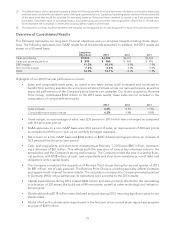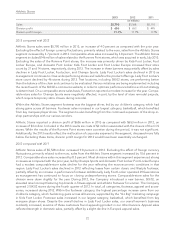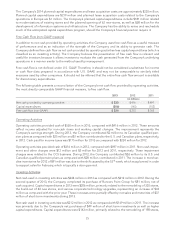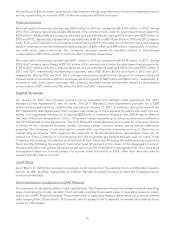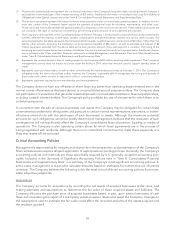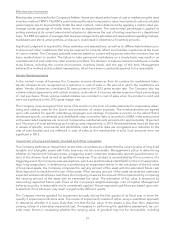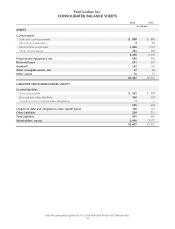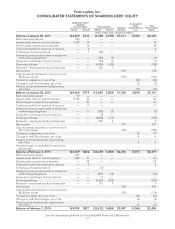Foot Locker 2013 Annual Report Download - page 51
Download and view the complete annual report
Please find page 51 of the 2013 Foot Locker annual report below. You can navigate through the pages in the report by either clicking on the pages listed below, or by using the keyword search tool below to find specific information within the annual report.
(1) The amounts presented above represent the contractual maturities of the Company’s long-term debt, including interest; however, it
excludes the unamortized gain of the interest rate swap of $13 million. Additional information is included in the Long-Term Debt and
Obligations Under Capital Leases note under ‘‘Item 8. Consolidated Financial Statements and Supplementary Data.’’
(2) The amounts presented represent the future minimum lease payments under non-cancelable operating leases. In addition to mini-
mum rent, certain of the Company’s leases require the payment of additional costs for insurance, maintenance, and other costs.
These costs have historically represented approximately 25 to 30 percent of the minimum rent amount. These additional amounts are
not included in the table of contractual commitments as the timing and/or amounts of such payments are unknown.
(3) The Company’s other liabilities in the Consolidated Balance Sheet at February 1, 2014 primarily comprise pension and postretirement
benefits, deferred rent liability, income taxes, workers’ compensation and general liability reserves, and various other accruals. The
amount presented in the table represents the Company’s 2014 Canadian qualified pension contributions of $2 million. Other than this
liability, other amounts (including the Company’s unrecognized tax benefits of $46 million, as well as penalties and interest of $2
million) have been excluded from the above table as the timing and/or amount of any cash payment is uncertain. The timing of the
remaining amounts that are known has not been included as they are minimal and not useful to the presentation. Additional informa-
tion is included in the Other Liabilities, Financial Instruments and Risk Management, and Retirement Plans and Other Benefits notes
under ‘‘Item 8. Consolidated Financial Statements and Supplementary Data.’’
(4) Represents the unused domestic lines of credit pursuant to the Company’s $200 million revolving credit agreement. The Company’s
management currently does not expect to borrow under the facility in 2014, other than amounts used to support standby letters of
credit.
(5) Represents open purchase orders, as well as other commitments for merchandise purchases, at February 1, 2014. The Company is
obligated under the terms of purchase orders; however, the Company is generally able to renegotiate the timing and quantity of
these orders with certain vendors in response to shifts in consumer preferences.
(6) Represents payments required by non-merchandise purchase agreements.
The Company does not have any off-balance sheet financing (other than operating leases entered into in the
normal course of business as disclosed above) or unconsolidated special purpose entities. The Company does
not participate in transactions that generate relationships with unconsolidated entities or financial partnerships,
including variable interest entities. The Company’s policy prohibits the use of derivatives for which there is no
underlying exposure.
In connection with the sale of various businesses and assets, the Company may be obligated for certain lease
commitments transferred to third parties and pursuant to certain normal representations, warranties, or indem-
nifications entered into with the purchasers of such businesses or assets. Although the maximum potential
amounts for such obligations cannot be readily determined, management believes that the resolution of such
contingencies will not significantly affect the Company’s consolidated financial position, liquidity, or results of
operations. The Company is also operating certain stores for which lease agreements are in the process of
being negotiated with landlords. Although there is no contractual commitment to make these payments, it is
likely that leases will be executed.
Critical Accounting Policies
Management’s responsibility for integrity and objectivity in the preparation and presentation of the Company’s
financial statements requires diligent application of appropriate accounting policies. Generally, the Company’s
accounting policies and methods are those specifically required by U.S. generally accepted accounting prin-
ciples. Included in the Summary of Significant Accounting Policies note in ‘‘Item 8. Consolidated Financial
Statements and Supplementary Data’’ is a summary of the Company’s most significant accounting policies. In
some cases, management is required to calculate amounts based on estimates for matters that are inherently
uncertain. The Company believes the following to be the most critical of those accounting policies that neces-
sitate subjective judgments.
Acquisitions
The Company accounts for acquisitions by recording the net assets of acquired businesses at fair value, and
making estimates and assumptions to determine the fair value of these acquired assets and liabilities. The
Company allocates the purchase price of acquired businesses based, in part, upon internal estimates of cash
flows and considering the report of a third-party valuation expert retained to assist the Company. Changes to
the assumptions used to estimate the fair value could affect the recorded amounts of the assets acquired and
the resultant goodwill.
28


